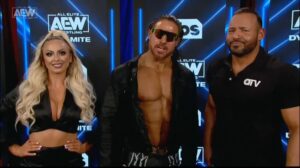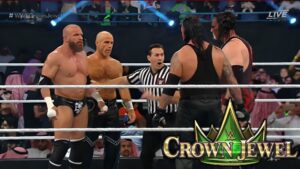Recently, Dave Meltzer of the Wrestling Observer Newsletter, reported that New Japan Pro Wrestling has an initial bid on the Cow Palace in California for July 7th (the same night as UFC 226 in Nevada, interestingly enough) of this year. This would be an unprecedented step for them, since the company is already running a show in Long Beach later this month, and has never ran two solo shows in the United States in the same calendar year before. The company is focused on the West Coast currently for their US expansion, operating a dojo in LA in addition their Long Beach shows both this year and last. But the Cow Palace, on top of being in their focused region on the Pacific coast, is also a very strategic selection for a venue. New Japan hopes to capitalize on the storied pro wrestling history associated with the famed arena.

Completed in 1941, the Cow Palace is an iconic venue for wrestling fans on the Golden Coast. The odd name was coined by a local newspaper journalist during the Great Depression, when he was writing against using public funds to build it. It was originally constructed to house livestock during animal expositions, so the writer argued the immorality of letting people starve while taxes paid for a “palace for cows.” The venue, located in Daly City just south of San Francisco, became famous for wrestling for one reason: Roy Shire. Shire, a pro wrestler from the 50’s best known for teaming with Ray Stevens (then known as Ray Shire), started promoting Northern California in 1961. He ran his first show at the Palace on March 4th of that year. That show was headlined by “Cowboy” Bob Ellis versus Ray Stevens, drawing over 16,000 attendees. Stevens, along with the likes of Pat Patterson, Rocky Johnson, Peter Maivia, the team of Mitsu Arakawa and Kinji Shibuya, Roddy Piper, Don Muraco, Kevin Sullivan, and Dick Murdoch were just some of the stars that came through the Cow Palace under Shire’s banner. The shows at the Palace remained strong after it’s explosive start: in 1962 alone, Shire’s promotion, called Big Time Wrestling, drew $1 million to the Cow Palace, averaging an attendance of 14,000 to all the promotion’s shows. Throughout the rest of the sixties and to the mid-seventies, Shire’s federation continued to do tremendous business at the Cow Palace, remaining a mainstay of the company and the only major wrestling show in town, having run the NWA San Francisco territory out of business in 1961. However, the late seventies turned out to be a totally different story.

After losing one of its top performers, Pat Patterson, and other factors, Big Time Wrestling’s business began to decline. But, even though attendance dropped in other venues across the territory, metrics at the Cow Palace persisted. They often did 8,000 there, and would even hit 12,000 for the promotion’s Battle Royal shows, the flagship events for the federation at the time. Eventually, Shire stopped promoting around the territory, and only promoted at the Cow Palace. However, a series of events led him to give up on promoting all together: in 1979, Big Time Wrestling’s local TV was cancelled; in 1980, Roy Shire had a heart attack; and in 1981, Verne Gagne’s American Wrestling Association began running shows in Northern California. He decided to quit the business instead of fight for his already diminished territory. He ran his last show at the Cow Palace on January 24th, 1981, headlined by a Battle Royal, which drew approximately $64,000. Shire later commented that he “went out with a bang.” Big Time Wrestling at the Cow Palace, a near twenty-year institution, was over.

On June 19th, 1982, Gagne’s AWA ran its first show at the Cow Palace, featuring former local stars Pat Patterson and Ray Stevens. It was headlined by a two-on-one handicap match: Nick Bockwinkel and Bobby Heenan versus Hulk Hogan. And yes, Hogan went over. The Minnesota-based promotion came back in August of that same year, and over the next two years they increased the frequency of their visits at the Palace: doing four shows there in 1983 and ten in 1984. But, in 1985, a promoter other than Verne Gagne decided that he wanted to run shows in San Francisco: Vincent Kennedy McMahon. Vince, Jr’s World Wrestling Federation came to the Cow Palace four times that year, while the AWA dropped to only three visits; in ’86, the WWF did 6 shows while the AWA didn’t perform there at all; and come 1987, McMahon’s federation did five house shows and a TV taping, when Gagne only promoted two shows at the Palace that year. Their second show that year, a supposed “super-show” called SuperClash II, featuring Curt Hennig versus Nick Bockwinkel, only drew approximately 2,800, a dismal number, especially when compared to the 14,600 the WWF drew to a TV taping the following year. After that disappointment on May 2nd, 1987, the American Wrestling Association never ran a show at the Cow Palace again.

For almost a decade, from August 1987 until February 1997, the World Wrestling Federation was the only major wrestling promotion to promote any shows at the Cow Palace. However, in the late nineties, a second American federation began gaining steam: World Championship Wrestling, and they started expanding into the entire country, including the Golden Coast. They performed SuperBrawl VII on February 23rd, 1997. Dave Meltzer called the event, “…the single most anticipated live event in this area in the past 25 years, and that includes the legendary San Francisco Battle Royals of the 70s and the biggest Pat Patterson or Ray Stevens match.” This was a testament to both the heat of the nWo angle, and the staleness of the wrestling in the area over the previous few years. The show drew a 13,324 attendance and a $192,000 gate. WCW came back the next year for SuperBrawl VIII on February 22nd, 1998, drawing 12,620 to the Palace, and setting new record gate for the city of nearly $311,000, plus $127,000 in merchandise. WCW continued to dominate wrestling at Roy Shire’s old home base: they ran two house shows there in 1999, SuperBrawl again in 2000 (drawing only 8,569, a reflection of WCW’s poor status at the time), and a Nitro in October of that same year. During all of this, WWF was averaging about one house show there every other year since 1994, and hadn’t done any TV at the Palace since 1990. And from October 2nd, 2000, to February 15th, 2004, the Cow Palace saw no major wrestling promotions run through its doors. No house shows, no TV tapings, nothing. This famed arena, that used to see Roy Shire’s events weekly, endured three and a half years without any significant professional wrestling happening under its roof. The Cow Palace had ceased to be major venue for contemporary sports entertainment.

On that day in February 2004, the most recent noteworthy pro wrestling instance at the Cow Palace took place: Eddie Guerrero scored a shocking victory over Brock Lesnar to win the WWE Championship at No Way Out. The San Francisco faithful exploded in joy, the moment forever cemented in the minds of all of those who experienced it. Afterwards, however, the Cow Palace continued to be generally ignored in the world of pro wrestling. WWE had a TV taping there the following year, but hasn’t filmed any TV at the famed Cow Palace since. Ring of Honor ran an event there of little note in October of 2007 called Chaos at the Cow Palace. All Pro Wrestling, though, has run a couple of shows there in the last couple years, most significantly on May 6th, 2017 where they drew almost 3,000 people, one of the largest non-WWE crowds there in recent years. And yes, Pat Patterson was there. However, that 3,000 was far from the capacity Patterson experienced during the glory days of pro wrestling at the Cow Palace.

New Japan is looking to change that. With the right card, they could easily hit the five-digit mark for paid attendance, especially if that is the event the Tetsuya Naito and Chris Jericho angle, which was teased on January 5th’s show New Year Dash, is blown off. New Japan has been very outspoken about its desired expansion into the USA, and selling out the Cow Palace would be a grand statement about their ability to do so. The company has the stars and the storylines to do tremendous business here; and now, with the selection of the Cow Palace as their next footstep into the American market, they have the right venue, too.






